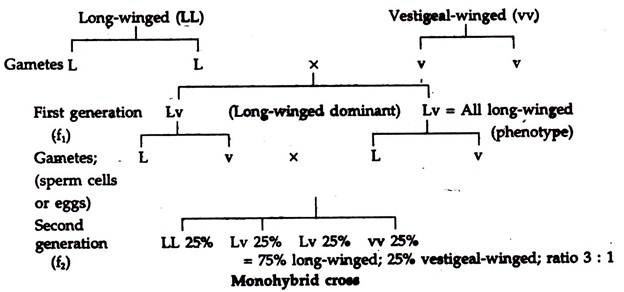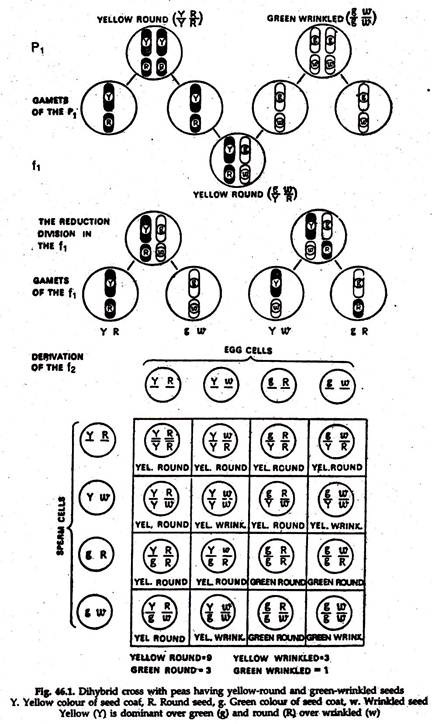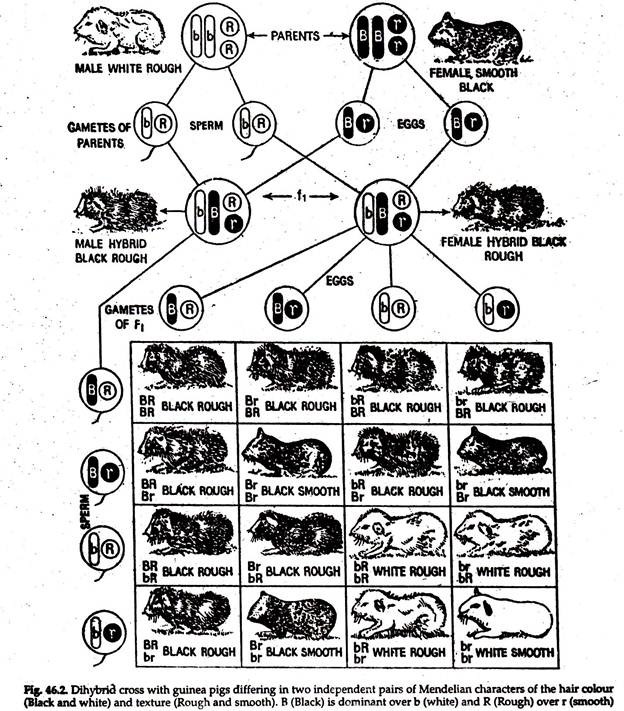In this article we will discuss about the Mendel’s law of heredity.
From his experiments on plant crossing Mendel established the basic laws of genetics. He carried his plant crossing experiments with ordinary garden peas (Pisum sp.). Mendel selected pure tall and pure dwarf plants for crossing.
These are contrasting characters. It was found that when two contrasting characters are brought together in a cross, one is dominant (expressed or evident) in the next filial (f1) generation, and the other refrains recessive (latent or recedes from view).
Likewise, tallness is dominant over dwarfness. The factors responsible for a pair of alternative or contrasted characters are termed alleles (allelomorph). A class of offspring as determined by genetic composition is referred to as a genotype and one determined by its appearance is referred to as phenotype.
ADVERTISEMENTS:
Description:
Pure tall and pure dwarf plants were crossed and all the seeds obtained produced hybrid tall in the first generation (f1), the dwarfness remained suppressed. As a result of random crossing in the first generation, the plants of the second generation (f2) were, on the average, 75% tall and 25% dwarf. Thus, dwarfness, which was suppressed in the first generation became expressive, in a quarter of the second generation.
When the f2 dwarf plants were self-pollinated, only dwarf plants resulted (f3), whereas among the tall f2 plants, 25% produced pure tall and 50% produced tall and dwarf plants in the ratio 3: 1, showing that in 50% plants of f2 the introduced characters were not completely separated.
Thus, of the tall and dwarf characters, the tall became dominant in f1 generation but in the following f2 generation these two characters were segregated or separated, in an average 3 to 1 ratio. Experiment with long-winged and vestigial-winged vinegar fly. Long wing dominant over vestigeal wing.
Di-hybrid Cross:
When individuals differing in two pairs of contrasting characters are crossed, such an experiment is known as di-hybrid cross:
1. Mendel crossed a variety of peas producing yellow and round seeds with one producing green and wrinkled seeds. He knew that yellow colour (Y) is dominant over green (g) and that wrinkled seed- surface (w) is recessive to round (R).
The f1 generation hybrid seeds were, as expected, yellow and round. This fi hybrid produced four types of gametes and a Punnett checker board shows 16 possible combinations in f2 generation (Fig. 46.1).
The f2 phenotypes include 9 yellow-round (YR) like the dominant parents, and 1 green- wrinkled (gw) like the recessive parents.
Two new combinations appeared of which 3 were green-round (gR) and 3 yellow- wrinkled (Yw). The 9 : 3 : 3 : 1 ratio is characteristic of a di-hybrid cross.
Considering one pair of contrasting characters, there are 9 + 3 = 12 yellow to 3 + 1 = 4 green and 9 + 3 = 12 round to 3 + 1=4 wrinkled seed-producing individuals. Thus, the ratio of 3 dominant to 1 recessive in each case follows Mendel’s first law, as in a monohybrid cross. Thus Mendel found that each pair of character is inherited independently of the other.
2. The di-hybrid cross may be illustrated in the case of guinea pig where black coat (B) is . dominant over white (b) and rough coat (R) is dominant over smooth (r). The mating of white-rough with black-smooth results black-rough hybrid. The black-rough of fi generation of each sex produces four kinds of gametes.
When the members of f1 generation are intercrossed, sixteen possible combinations appear in the f2 generation. The f2 phenotypes include 9 black-rough (BR) like the dominant parents, and 1 white- smooth (br) like recessive parents.
Two new combinations have appeared, of which there are 3 black-smooth (br) and 3 white-rough (bR). As in di-hybrid crosses with pea, 9 : 3:3:1 ratio is obtained (Fig. 46.2). It is the characteristic of a di-hybrid cross.
Mendel formulated the following laws from these experiments:
1. Law of segregation (from monohybrid cross):
ADVERTISEMENTS:
Whatever unit characters may be introduced into the zygote at fertilization, such factors are not completely blended, but are separated out in the gametes it produces.
2. Law of independent assortment (from di-hybrid cross):
When considering two or more pairs of unit characters, the inheritance of each pair of unit character is independent of the other.


